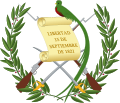| |||||||||||||||||
| |||||||||||||||||
| |||||||||||||||||
| This article is part of a series on |
| Politics of Guatemala |
|---|
 |
Presidential elections were held in Guatemala on 11 April 1910. Manuel Estrada Cabrera was re-elected unopposed. [1] His new term started on 15 March 1911.
| |||||||||||||||||
| |||||||||||||||||
| |||||||||||||||||
| This article is part of a series on |
| Politics of Guatemala |
|---|
 |
Presidential elections were held in Guatemala on 11 April 1910. Manuel Estrada Cabrera was re-elected unopposed. [1] His new term started on 15 March 1911.
| Candidate | Party | Votes | % | |
|---|---|---|---|---|
| Manuel Estrada Cabrera | Liberal Party | 551,145 | 100.00 | |
| Total | 551,145 | 100.00 | ||
| Source: Rendón [2] | ||||